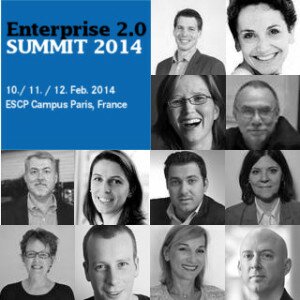 In our pre-Summit interview series we turn our attention towards Bernar Marie Chiquet. Bernard is founder of IGI Partners and he is the first Holacracy Master Coach in Europe, the highest degree certification for Holacracy.
In our pre-Summit interview series we turn our attention towards Bernar Marie Chiquet. Bernard is founder of IGI Partners and he is the first Holacracy Master Coach in Europe, the highest degree certification for Holacracy.
Bernard will grace us with his presence on the second day of the Enterprise 2.0 Summit. He will team up with Lee Bryant to discuss Defining the Leadership Model and Design of the 21st Century Organisation.
This is part of the objective for the Enterprise 2.0 SUMMIT 2014; blurring the lines between social and business, and preparing companies for the future.
1) Bernard – you are a speaker at Enterprise 2.0 SUMMIT 2014 in the session about the new design models for the 21st century organizations. Which three tags are labelling your talk?
#Purpose, #Productivity, #Engagement
2) So – what is the HolacracyOne idea? And why do we have to talk about it?
HolacracyOne is a company developping and spreading Holacracy worldwide.
I will start with the why. Why do we have to talk about a new governance structure?
Have you ever experienced this type of challenges in your organization: Painful meetings, difficulty with change, overwhelm, fear, unclear decision-making, communications issues, lack of engagement, alignment issues, analysis paralysis, rigidity, politics, etc. ?
Conventional approaches to management tend to stifle agility and creativity. Predict-and-control techniques struggle to keep up with today’s rapid change and dynamic complexity. Time and energy is wasted with painful meetings, ineffective decision-making, and rigid bureaucracy.
We have developed a lot of new techniques to try to solve this issues such as Team Building, Open Space Technology, Coaching, Lean Management and yet, it doesn’t work and we are still running our organizations with the old-fashion pyramid hierarchy, invented by Fayol 100 years ago!
Holacracy offers an alternative:
- Holacracy is a comprehensive “operating system” for structuring, governing, and running an organization. It replaces today’s top-down predict-and-control paradigm with a new way of distributing power and achieving control.
- Holacracy changes the power structure of the organization and places the seat of organizational power in an explicit process.
- Holacracy harnesses the full capacity of the humans in the organization and allows anyone who senses a “tension” about improving the organization process it into meaningful change.
- Holacracy obsoletes organizational politics because with Holacracy at play, if an expectation isn’t explicitly defined via a governance process, no one has a right to expect it.
- Holacracy supports a truly purpose-driven organization as it is governance of the organization, through the people, for the purpose.
3) To which kind of organization is the idea of the holacracy model suitable and applicable?
There is no such kind of things: organizations suitable for Holacracy vs organizations not suitable for Holacracy. Our clients are CEOs willing to change the way they run their company because they know it’s time to leave the statu quo. They are the pionneers, those who want to do things differently because they have suffered a lot and are appealed to Holacracy. Therefore, our clients come from different areas, countries and have different sizes. Here are some of the company that have implemented/are implementing Holacracy:
- Zappos, 1500p, e-commerce US
- SOPRODI, 50p, Industry FR
- Antonutti-Delmas, 300p, Transport FR
- Medium, Social Network US
- Precision Nutrition, 50p CA
- Conscious Capitalism, NGO US
- David Allen Company, 60p, productivity US
- IMC2, 350p, US
- Kingfisher/Castorama, UK & FR (Pilots)
4) The core building blocks of the holacracy model are strong leadership patterns and flattened self-organizing circles. Can we really build a whole organization on this principle – also in regards to the part of the organization that run on the technical getting-the-work-done side?
Key elements to describe Holacracy are the distributed authority system (governance process) and the organizational structure (organization the work, not the people) but you are right, there is a missing part here.
We also have operations. And 98% of the time we spend is just doing our work, right? Meetings (in an holacratic organization at least) just take 2% of our time. I would say there is no more “getting-the-work-done side”. Everybody works in an holacratic organization, including managers. And there are no longer managers. Instead, we have got clear authorities, roles autonomous but still aligned, doing their work.
With that added, I definitely think we can build a whole organization on this principles. Let me explain here how:
Point 1 is the organizational structure. We are used to organizing around the people.
We put people reporting to other people, we are structuring power all around the people. Holacracy makes a shift.
We’re not organizing the people with Holacracy. We are organizing the work. Instead Holacracy organizational structure is not a management hierarchy of people, it is a structure of breaking down the work and the authority to go with it. We are looking for what are the functions we need within those functions what are the roles we need, what do we need to expect of those roles. What authorities do those roles need to have to do the work to express the purpose.
That’s what we’re constantly doing in Holacracy and this is done through the governance process, point 2.
This governance process is about distributing authority, it is giving people autocratic authority and we do that using a highly integrative process that gives everyone a voice and make sure everyone has some engagement in that process. Everyone can get what they are sensing processed.
Each team has this highly collaborative integrative process for breaking up autocratic authority and then when we get to execution which is point 3 here “operations” that’s where we get work done, we execute in our clear authority and most of that happens through one person with clear authority knowing it’s my job to decide and knowing what’s expected of me.
We have different processes to facilitate that as well.
5) What role does the social technology play in the implementation of the holacracy idea?
Holacracy is a new social technology, just like a top-down management hierachy, is a social technology for organizing around some goal to generate results that are aligned in order to integrate the effort of so many people. And there are other social technologies available to do that as well and one of them is Holacracy. Holacracy is a new social technology for organizations.
So when we implement Holacracy, we say: “ok, we had this technology before and now we decide to play a new game with new rules”. These new rules are referenced in a document so that anyone know what to expect. Our goal when implementing Holacracy is to help organizations playing the game, we help them to put this new social technology in place and make the shift.
If you want to learn more, visit the Enterprise 2.0 Summit for the expertise panel: Defining the Leadership Model and Design of the 21st Century Organisation with Bernard and Lee Bryant.











Last Comments